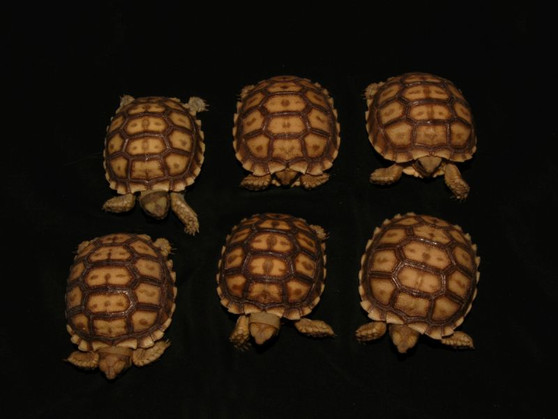Product Description
Some Sulcata tortoises are born with a few markings on their scutes. Normally, these are random, incidental and minor - or more often are missing entirely. From time to time one out of every several hundred pops up with a very exact pattering on it's shell - that sharply stands out from the rest... We've hatched an entire small clutch (6), all born with very distinct patterns on each shell scute. Almost perfectly symmetrical, these markings follow a precise design (see photos) on each tortoise - and each one is completely different from the next...
Something a little different - or one for the keeper looking for a Sulcata tortoise that stands out... Each of these tortoises behaves just like it's normal colored counterparts who's general description follows:
Sulcata tortoises, also called African spurred tortoises, originally came from hottest and driest regions of Northern Africa. Their importation ended in 2000, so nearly all available animals are captive born here in the US. Breeders now produce this species readily, and well started juvenile Sulcatas are relatively easy to work with. This species does best when kept in low humidity, but juveniles need more moisture and we soak ours two or three times each week in warm shallow water until they reach 8(at about 4 - 6 years). Sulcatta Tortoises are a desert species and should never have a water bowl. Constant access to greens and short, shallow soakings (3 times a week for hatchlings, twice a week for yearlings and two year olds, and once each week for adults) is their source of hydration. Juveniles do best between 80 f - 90 f with warmer basking areas.
As adults, Sulcatas can grow to 24, and do best outdoors in warmer climates or in warmer months. Outdoor enclosures must afford shaded areas, and protection from predators. Daytime temperatures up to 103 f, and night time lows in the high 60s are fine for larger Sulcattas. Keepers in colder climates need to provide indoor enclosures once the warmer months end. Opaque fencing is recommended, along with lots of room. They enjoy provided shelters, or will even dig tunnels to escape the cold, or wet weather.
Sulcatas are eating machines and juveniles will graze on grasses, hay, and tortoise pellets mixed with veggies for hours at a time. Adults do well on mostly grasses; and all sizes enjoy dark leafy greens fruits and vegetables in moderation. A calcium supplement is an important part of their diet. Care must be taken to be sure that foods containing protein or too much phosphorus are avoided, and that colorful, non edible items are not with in reach. Sulcatas try to climb, and care must be taken to prevent them from flipping over.
The USDA requires a veterinary health certificate for Sulcattas (and Leopard Tortoises) to be shipped from state to state. The Turtle Source is pleased to provide these health certificates for a small fee of $12.95. Obtaining the health certificate may delay shipping by one day.
Other Details
Warranty Information
Reviews
-
Baby Sulcata
Highly recommended vendor. Ship on time and arrived safe.
-
Sulcata
We adore our new family member! Thank you for the safe delivery of our baby.
-
Sulcata
Beautiful tortoise. Fast ship in excellent health.
-
Patterened Sulcata Tortoises
Beautiful Tortoise. I can't say enough about the Turtle Source. Great company which produces great animals!




